iBUYPOWER Erebus GT Review: Ivy Bridge and NVIDIA's GeForce GTX 680 in SLI
by Dustin Sklavos on April 27, 2012 2:00 AM ESTApplication and Futuremark Performance
What we're essentially trying to gauge here is how an Ivy Bridge processor with reduced overclocking headroom compares to a Sandy Bridge chip with lower IPC and higher clocks. In the process, we can also see how both of them compare to chips with lower IPC and extra cores (specifically Gulftown and Sandy Bridge-E).

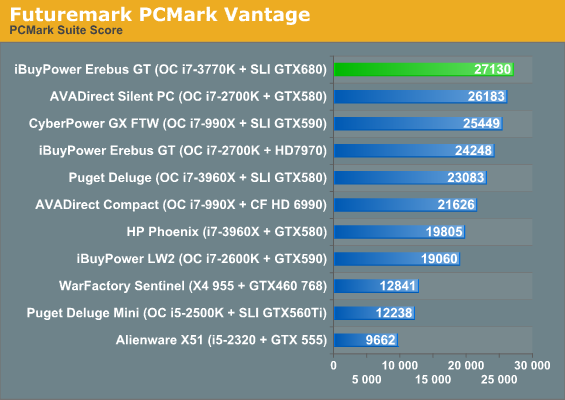
Out of the gate the PCMarks are both responding well, but I suspect that may also be due to the Intel SSD employed in this Erebus GT. It may still be using SandForce's controller, but it's Intel's firmware. Whatever the case, for general use the new Erebus GT screams through PCMarks, delivering a 7% increase in PCMark 7 and 12% in Vantage compared to the previous model.
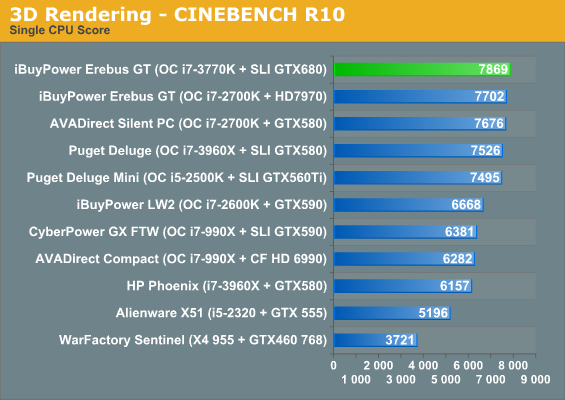
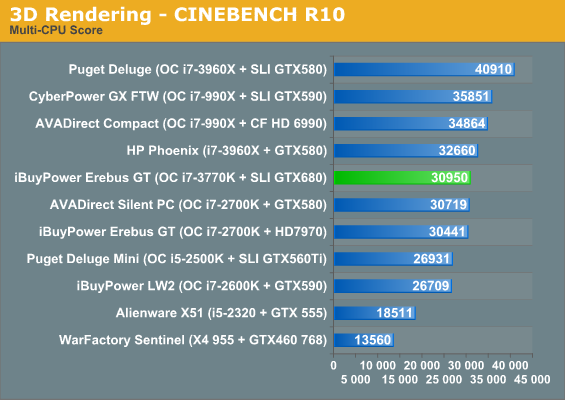

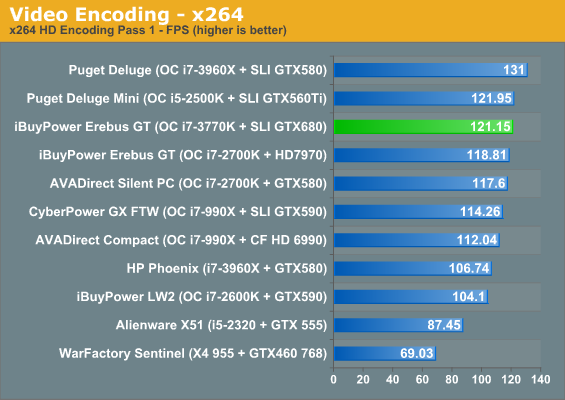
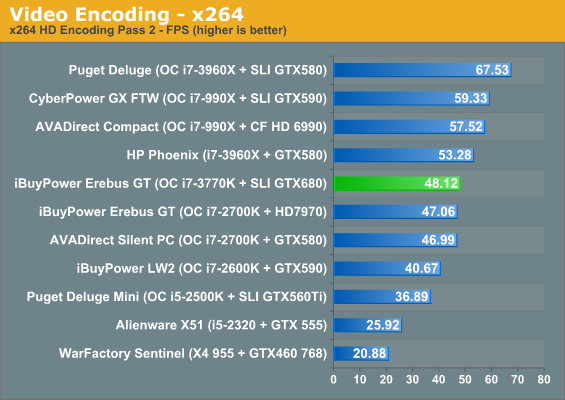
Looking at the CPU-dependent benchmarks may or may not be troubling, depending on your perspective. From the looks of things, Ivy Bridge's improved IPC is almost entirely mitigated by its reduced overclocking headroom. The IVB Erebus GT is a scant 2% faster in most of our CPU tests, with the SNB variant actually taking a slight 1% lead in Cinebench 11.5. What's interesting is that on the CPU side, even overclocking and increased IPC still doesn't bridge the gap between Intel's quad cores and their hexacores; the i7-990X still runs wild in any task that can take advantage of the extra cores.
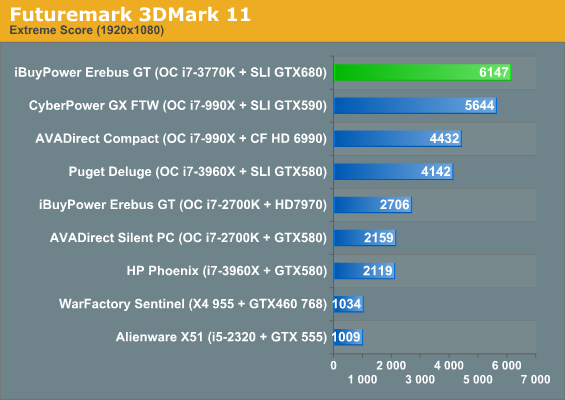
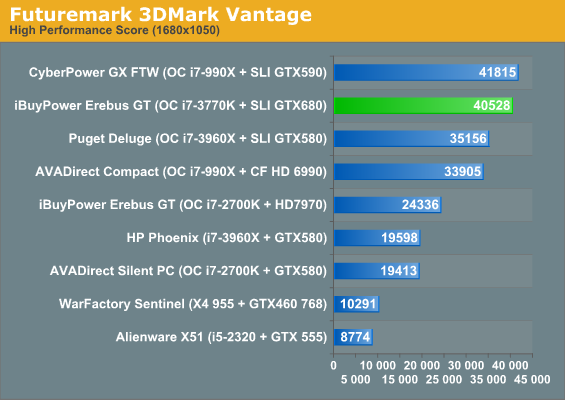
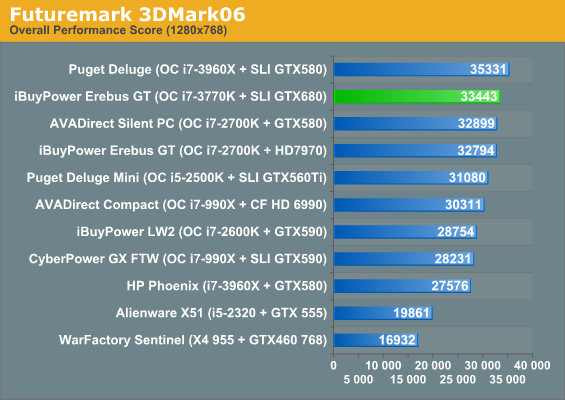
What can we take away from the 3DMark results? 3DMark06 is always going to be CPU-limited (and probably should be deprecated at this point), but in 3DMark Vantage's older workload we see a pair of GTX 680s essentially equaling the performance of two GTX 590s. That's two current generation GPUs hitting stride with four of last generation's. When you get to 3DMark11, the GTX 680s just run away with it. This is important, remember it, because it's going to come up again when we get to power consumption.










64 Comments
View All Comments
Kimbernator - Friday, April 27, 2012 - link
1200w for 2 680s? that's probably not wasteful.Never buy prebuilt gaming computers, building is cheaper and you'll get better performance.
Sabresiberian - Friday, April 27, 2012 - link
Well, Nvidia's recommendations would put the PSU at 750W for 2 680s in SLI.You need some headroom if you plan to overclock the video cards, but I don't see that requiring another 450W. An 850W PSU should be more than plenty, unless you want room for installing 2 more cards, or 1 more card and plenty of room to OC the 3.
You did read the test results showing max draw to be less than 500W, right?
It's all good to say "never buy pre-built" when you personally have the time and inclination, and I more or less agree with the sentiment, but rigs like this one from iBUYPOWER are very much known quantities - everything in it is name-brand, and the unit itself has been tested here at Anandtech favorably. I wouldn't fault anyone for buying this rig over building his own.
;)
DigitalWolf - Friday, April 27, 2012 - link
"We've heard that Ivy Bridge runs hotter than Sandy Bridge does, and I can confirm those findings by comparing the thermal readings from our Sandy Bridge-based Erebus GT against our Ivy Bridge-based Erebus GT."The images that you have to compare the two systems... show the 2700k system with a maximum vcore of 1.06v and the 3770k with a maximum of 1.36v.
I would expect the system with .3 higher vcore to run "hotter" even if they were the same chip...
Nickel020 - Friday, April 27, 2012 - link
The same screenshot show that +12V is at a maximum of 7.03V... Don't put too much faith into software readings, especially with very hardware there are often errors. Given that the current value is 1.10V during idle, that 1.36V is likely just a freak reading, the VCore will not vary that much.Nickel020 - Friday, April 27, 2012 - link
*with very new hardware there are often errors.leonzio666 - Friday, April 27, 2012 - link
Where are Metro 2033, Mafia II, Witcher II with ubersampling and Crysis or Starcraft II MP benchmarks ??? No one, and I mean absolutely no one in their right mind would buy such a beast only to play the games tested.imaheadcase - Friday, April 27, 2012 - link
No one buys a system for just the games YOU listed to. Games are subject to the user, the games they used are POPULAR games so they went with them.Starcraft MP does not stress a GPU/CPU much. Metro 2033 is not a game many play, Mafia 2 not many play, etc.
jonbanh - Friday, April 27, 2012 - link
hmm, i would say starcraft 2 is pretty POPULAR. and if you say it doesnt stress the CPU/GPU enough, well you also have portal 2 up there hitting almost 300 fps. i would've liked to see metro 2033 also just because it's been one of the most demanding games so far. as well as crysis 2i always figured when systems are given to sites for reviews, the manufacturer provides "guidelines" for what benchmarks they want or dont want shown
Sabresiberian - Saturday, April 28, 2012 - link
Oh yeah, popularity is always the top reason a game should be included in a benchmark suite.Dustin should have included "Angry Birds".
;)
Tchamber - Friday, April 27, 2012 - link
When do you expect to get the chance to compare 7970s in CF to the 680s in SLI?